Sunrise, Sunset, and Twilight
What is Twilight?
Twilight is the time of day where the sky is lighter than the nighttime sky, but the Sun is below the horizon. When the Sun is just below the horizon, some of its light is scattered by atmospheric gases and tiny suspended particles, which lightens our sky and allows us to see. There are three stages of twilight based on what we can see when there are clear skies:
-
- Civil Twilight: the Sun is within 6º below the horizon, and there is enough light to carry out ordinary outdoor activities.
- Nautical Twilight: the Sun is between 6º and 12º below the horizon, but both the horizon and brightest stars are visible, so navigation is possible.
- Astronomical Twilight: the Sun is between 12º and 18º below the horizon, and there is only a faint sky glow at this time.
When the Sun is below 18º, astronomical observations are possible in the dark sky, unless light pollution is created by nearby human artificial lighting.
Dawn refers to the twilights associated with sunrise, and dusk are those that follow sunset.
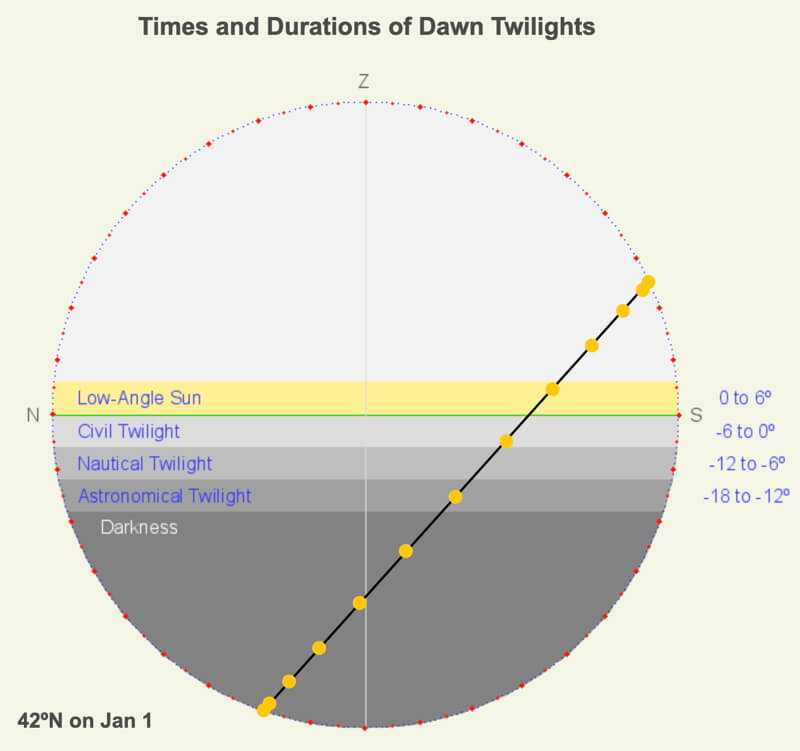
The Sun’s path for 42ºN on January 1 (black line), with the zones of twilight shown relative to the horizon (green line). The hourly positions of the Sun are shown as orange circles). See Interpreting Time on Declination Circles if these concepts are unfamiliar to you.
Romantic Sunsets 101
The first rule of romantic sunsets is that the romance should last well after sunset, especially when on a honeymoon. When my wife and I honeymooned on a tropical island, we walked down to a remote beach to watch the sunset. Since the sun sets so quickly in the tropics, and dusk is unexpectedly brief, we found ourselves trying to avoid the hundreds of awakening (and aggressive!) hermit crabs as we tried to find our way back along the densely vegetated path in our sandals. The memory of that romantic sunset was very short-lived! My advice if you want to enjoy a tropical romantic sunset: bring a flashlight! Better yet, use the following web apps to know how much time you have before it gets too dark to see where you are heading and what critters you may be walking on…
Not interested in romantic sunsets? The seasonal variability of how long twilights take affects our outdoor activities. Sports, walking the dog in the woods or park, hiking, jogging, etc. Any location poleward of 40ºN or S has times when twilight is considerably shorter than the rest of the year.
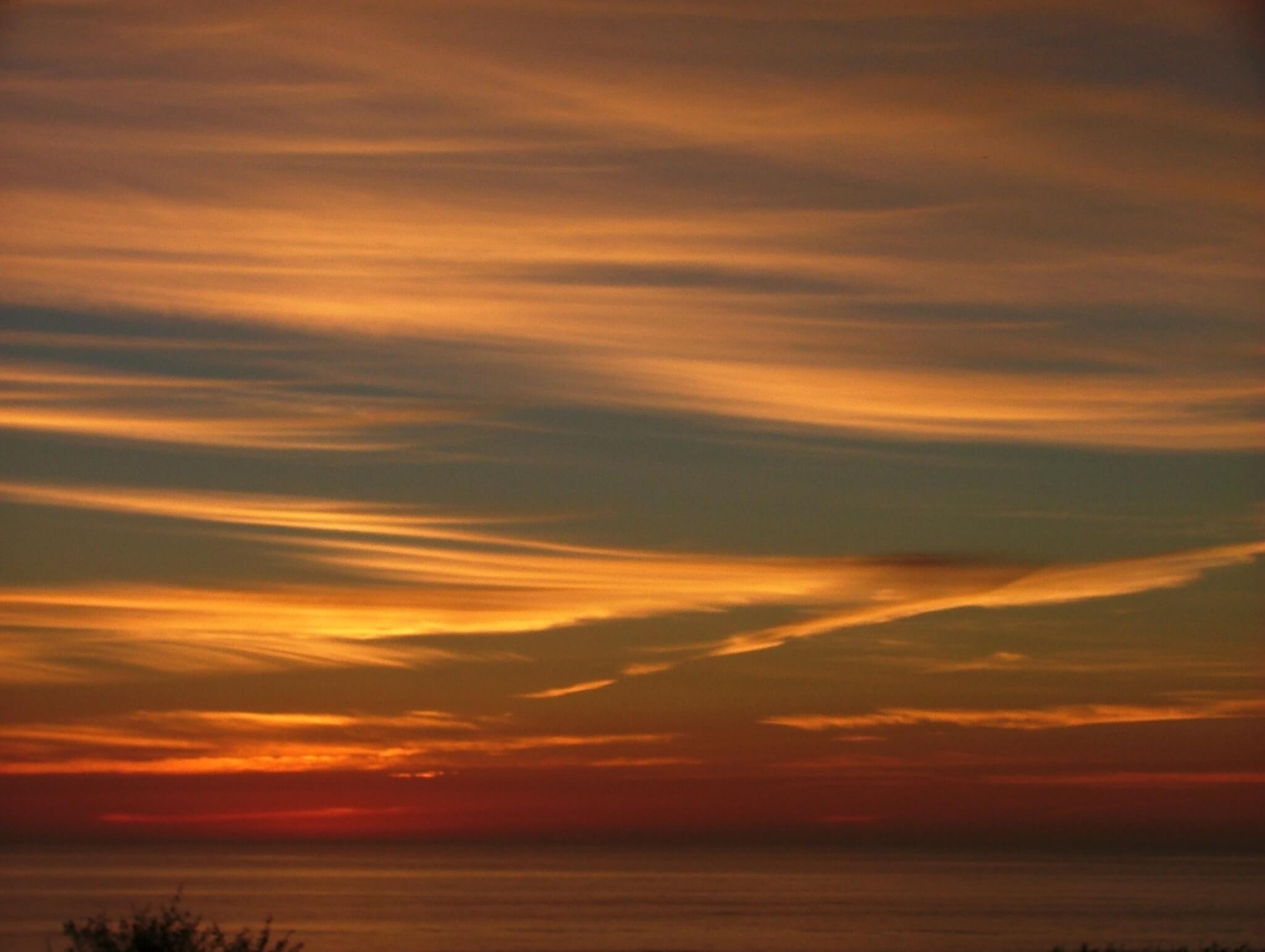
Sunsets may be romantic due to their dramatic colors, but be prepared for how quickly twilight passes (especially civil twilight) to maintain its romantic glow. Calculate how long the skylight contains yellows, oranges, and reds just before and after the sun sets (this period is referred to as the golden hour) using the app below, Times and Durations of Sun Angles.
Timing and Duration of Twilights
Since the Earth rotates at 15º per hour, the shortest time the Sun can move through one of the 6º bands of sun angle is 24 minutes, but this only happens at the Equator during an equinox. The twilight’s duration depends on the angle of the declination circle to the horizon and what time of day it occurred. Lower latitudes have steeper angles of the declination circle to the horizon, so they tend to have shorter twilights, and higher latitudes have longer twilights. For any given latitude, twilights will be the shortest when occurring near 6 AM/PM.
Click the button to run the web app for desktops, laptops, tablets, and smartphones.
Acknowledgments: Matti Horne’s suggestions improved this web app’s functionality and aesthetics significantly.
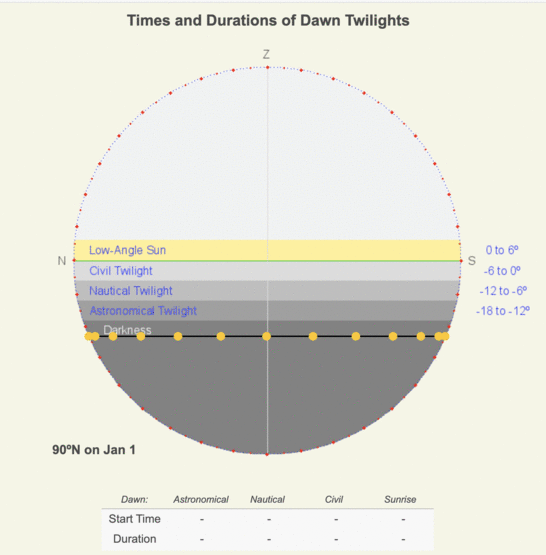
Animation of declination circles by 10° increments of latitude for January 1. Included are the 3 bands of twilight. Notice that the polar latitudes do not have twilight: they either experience 24 hours of sunlight or darkness at this time of year!
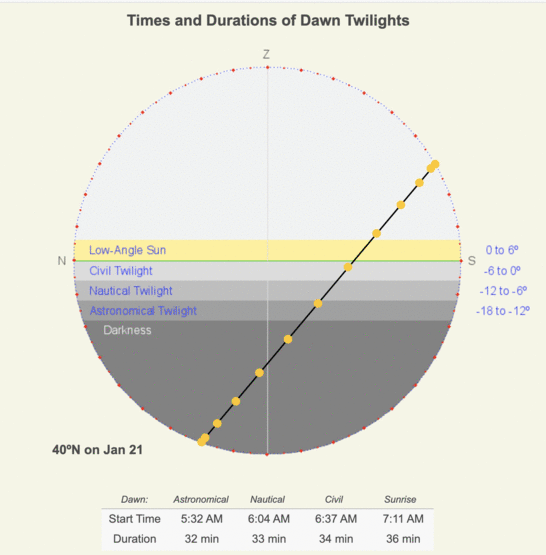
Animation of declination circles for 40°N on the 21st of each month. Included are the 3 bands of twilight.
Use the Calculating Twilights web app to calculate and visualize twilight at any latitude during any day of the year.
Note: The times calculated in the app are displayed in sun time or solar time, not clock time. Sun time is defined by local noon and midnight when the Sun is at the highest and lowest points to the horizon, respectively.
Sunrise is defined as when the sun first appears on the horizon, not when its geometric center crosses the horizon. Sunset occurs the moment the sun disappears below the horizon. The sunrise and sunset duration is the time it takes for the sun to transit across the horizon, and the size of the Sun in the sky is 0.5º.
To make it easier to compare to the 6º sun angle bands used for the three twilights, we defined low-angle sun as the time it takes for the sun’s geometric center to transit from 0º to 6º above the horizon.
Calculate a Year of Twilights
The Calculate Twilight web app above lets you calculate the timing and duration of twilights for a given day and location while also showing why the variations in time and duration occur. If you would like to see a year’s worth of twilight times and durations for a given latitude, use this Google Sheets document: Times and Durations of Twilight. Below are examples of data and graphs you may create using the app.
The file will open in Google Sheets, then use the “Make a Copy” in the File Menu so you may change the latitude to calculate and graph a year of times and durations of twilights. Tip: the name of your file should include what experiment(s) you are trying.
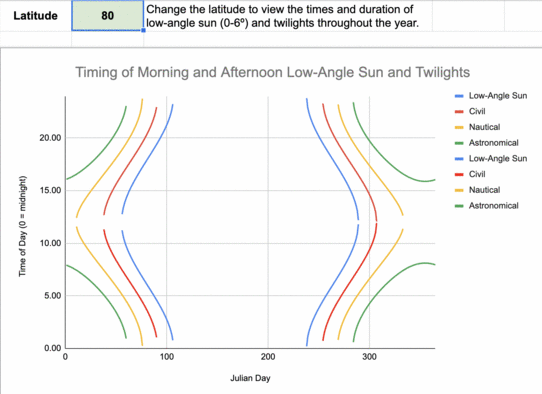
Animation of the yearly timing of twilight associated with dawn and dusk for every 10º of latitude.
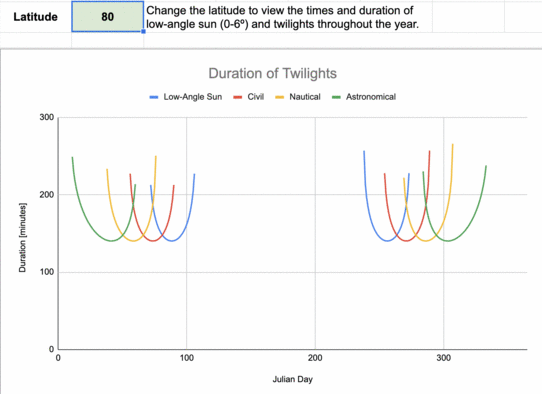
Animation of the yearly duration of twilights for every 10º of latitude. Notice that the duration scale on the vertical axis changes for each latitude.
Use the Times and Durations of Twilight app to calculate and visualize the timing and duration of twilights at any latitude for an entire year.
There are two sheets in the document:
-
- Input and Output: Change the latitude on this sheet and automatically see the graphs update.
- Calculations: See the data used to create the graphs in table form on this sheet, and explore the formulas used to calculate the times and durations of twilights.
Assumptions and Limitations of Both Apps
- They don’t take into account that a year is 365.25 days long (which creates our leap year), convert to clock time (use longitude and time zone), account for daylight savings time/standard time, or deal with Earth’s eccentric orbit (Equation of Time).
- They don’t account for atmospheric refraction.
Most of the assumptions and limitations above deal with calculating the times of twilight and low-angle sun; the errors cancel each other out (except for atmospheric refraction and eccentricity of our orbit) when calculating the duration of the sun traversing the sun angles, so the duration values are rather reasonable.
Math Modeling Challenges
Using the links in the Assumptions and Limitations section, modify the Times and Durations of Twilight spreadsheet with the following improvements:
-
- Add your longitude and time zone to convert sun time to clock time.
- Add daylight savings time if appropriate.
- Add that a year is ~ 365.25 days and that Earth’s orbit is slightly eccentric.
- Account for atmospheric refraction.
- Account for the size of the Sun (this is if calculating sunrise/sunset).
Compare your results to these advanced models available online: University of Toronto and StarGazing.net.
Photography and Low-Angle Light
Photographers have two favorite times when natural lighting conditions create dramatic art: golden hour and blue hour. The sky colors tend to range from reds, oranges to yellows during the golden hour, which is defined when the Sun is between 4º below and 6º above the horizon. During the blue hour, the Sun is between 4 and 6º below the horizon, and the sky tends to have deep blue shades.
Use the Times and Durations of Sun Angles app to calculate the time it takes for the Sun to transit two sun angles at a latitude you select. The interface is similar to the Google Sheets document above, Times and Durations of Twilight.
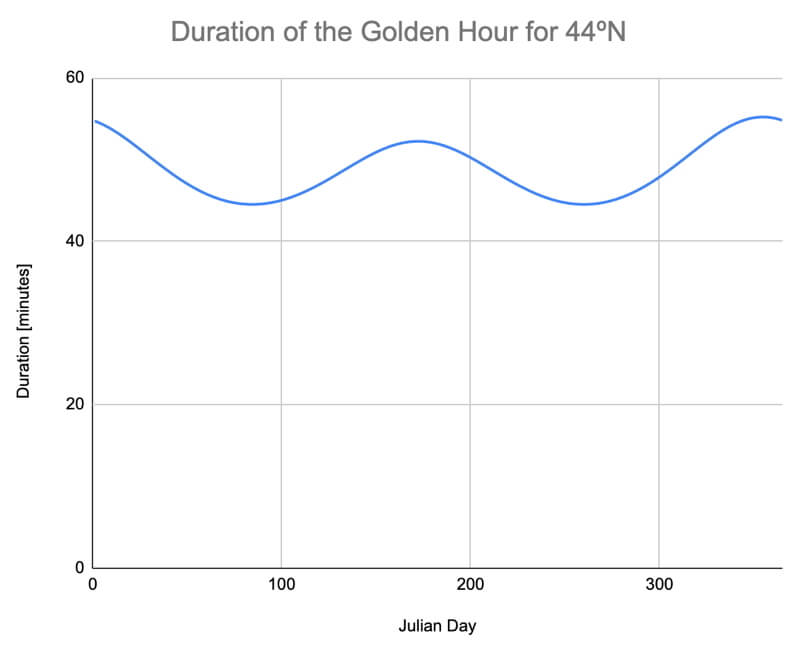
An example of the graphical output from the Times and Durations of Sun Angles app.

Even though the sun was below the horizon when this photo was taken, the golden hour can produce amazing tones of yellows, oranges, and reds!
Big Ideas
- Observed trends in the durations of twilights:
- Higher latitudes have a larger seasonal change in the duration of twilights (and sunrises/sunsets) than tropical latitudes,
- The longest twilights occur near the summer solstice (the summer solstice for the Northern Hemisphere is June 21 and December 21 for the Southern Hemisphere), and
- The shortest twilights occur closest to 6 AM/PM, which happens near the equinoxes.
Click on the following toggles to view descriptions and links of the web pages on each topic of the Sun-Earth Connection.
Sun-Earth Connection overview
An overview of how the Sun’s energy is generated and how its thermal radiation illuminates and heats Earth.
Earth Illumination Patterns
- Overview: The Sun illuminates the spherical, rotating planets orbiting it.
- Obliquity and Earth’s Illumination: Obliquity is the angle between the planes of the Earth’s equator and its orbit around the Sun.
- Declination, Latitude, & Earth Illumination: Solar declination is the angle between the Sun’s rays and the plane of the Earth’s Equator. Its value depends on where Earth is in its orbit around the Sun.
- Astronomical Seasons & Illumination: Astronomical seasons are based on the orientation of Earth’s axis of rotation to the Sun, which determines the amount of illumination between the Northern and Southern Hemispheres.
Distribution of the Sun's Energy on Earth
- Overview: Even though an area is illuminated by sunlight, there can be quite a range of energy interacting with the surface.
- Sun Angle and Beam Concentration: If every beam of sunlight reaching Earth has the same amount of energy, why do some areas warm up more than others?
- Diurnal Heating: Diurnal heating is the temperature change over 24 hours. When sunlight shines on the ground, it warms. Two critical factors that determine the amount of heating deal with the Sun’s illumination.
- Seasons: Earth experiences astronomical seasons due to its obliquity.
- Climate Regimes: Climate regimes are an extension of diurnal heating and seasons, but the time frame is now years.
Declination Circles: A tool to analyze the Sun's position in the sky.
- Overview: Drawings of declination circles contain the visual and numerical information to understand and predict the Sun’s motion across the sky.
- Declination Circles 101: Draw a declination circle with just a ruler and protractor/compass to quickly and accurately know the Sun’s position in the sky at any day and time of the year for any location on Earth.
- Drawing Declination Circles: Declination circles are quite easy to draw by hand.
- Interpreting Time on Declination Circles: Accurately estimate the time of day using the Sun’s location in the sky.
- Sunrise, Sunset, & Twilight: Calculate the timing and duration when the Sun is at or near the horizon.
- Solar Time, Angle, & Position: The sun’s angle and direction to the local horizon define the Sun’s position in the local sky. Explore how to use declination circles to calculate the Sun’s position at any solar time anywhere in the world on any day of the year.
- Changing Views of Declination Circles: Use the web app View Declination Circles to explore three common views of declination circles to identify their strengths, limitations, and applications. Then learn how to go from one view to another.
- Using Declination Circles: Humans have been using the apparent motion of the Sun as a compass, clock, and calendar for millennia.
- Using Sundials: Humans have been using the Sun’s position to navigate and tell the time, day, and season for millennia. Sundials create shadows that make it easier to do these tasks.

0 Comments